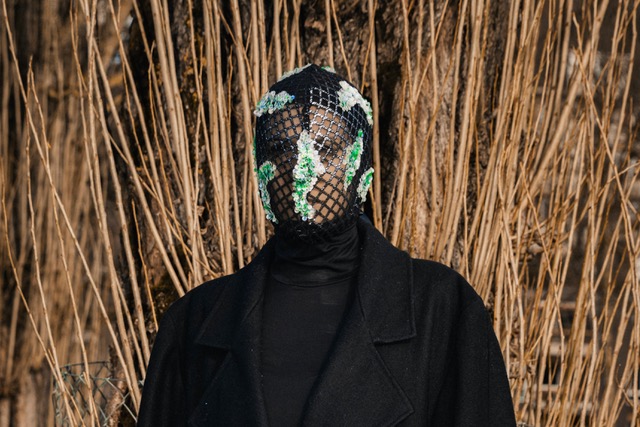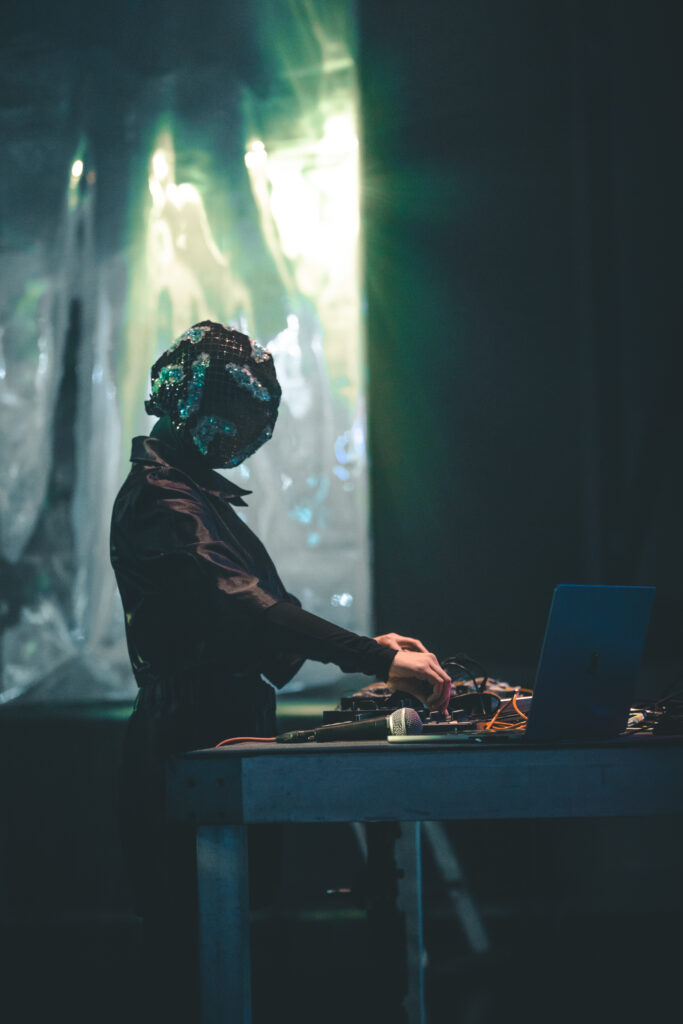
Marie Delprat (1991) is a musician whose work merges sound, visual arts, and performance. She explores the interaction between digital and analogue media. Collaborating with other artists from different backgrounds and cultures is central in her work. Dull Star Doll(2025): Live set with her duo Marytronics (Marie Delprat + Masha Ten). Ethereal Realms – all fiction is metaphor (2024): A performance exploring a persona she develops and interacts with on stage. Marie became an associate artist at Dampfzentrale (Bern) in 2023 and has been part of the Friendly Takeover programme organised by the Gare du Nord (Basel) between 2022 and 2025.
Can you tell us about your background? Did you have any musical training?
I’m classically trained, I studied the recorder and spent many years immersed in early music, especially Medieval, Renaissance, and Baroque repertoire. I studied at the Centre de musique baroque de Versailles before moving to Switzerland to continue at the Bern Academy of the Arts (HKB). After years of working within very structured musical systems, I felt the need to break free and explore new ways of making music. At the HKB, I had the chance to shift my practice toward improvisation, performance, and composition—a turning point that opened up my artistic language.
What are your creative inspirations? You seem to draw from classical, contemporary, and historical music. What is it that attracts you—is it the aesthetic or the sonic side of this music?
Lately, I’ve been very inspired by Baroque music, especially in how it relates to pop. For me, Baroque arias were the pop songs of their time—direct, emotional, and made to move people. There’s something in the way composers shaped melodic lines and placed the voice that feels close to the structure of a song today. Both share this intense relationship with emotion and form, with repetition and ornamentation. I like to think of my work as navigating between those two worlds: the intimacy of song and the architecture of early music.
For many of us, the Swiss music scene is not so well known. Can you talk about the infrastructure of the scene, possibilities for the musicians, and the ecosystem of the scene there?
When I arrived in Switzerland (some years ago now, haha), I was really surprised by how diverse and vibrant the scene is even if it might seem small from the outside. There’s a strong network of independent venues, festivals, and artist-run spaces that support experimental and electronic music, a mix of publicly funded institutions, underground initiatives, and everything in between.
What I also found special here was the proximity between disciplines. As a musician, I could often work with visual artists, performers, or dancers, which creates a very fluid and interdisciplinary ecosystem.
At the same time, Switzerland can feel a bit fragmented; the linguistic regions sometimes develop their own scenes and dynamics, so it takes time to connect them. But there’s a lot of curiosity and exchange happening now, and many artists are actively building bridges between cities and aesthetics, which makes it an exciting place to create.
Performance is also an important element of your work. How do you approach performance and the live presentation of your work?
Performance is central to my work; it’s where everything comes alive. I see it as a moment of exchange rather than presentation—a space where sound, body, and light interact. I’m interested in creating immersive atmospheres that can transform the perception of time and space, whether through movement, light, or the spatialisation of sound. I like when things stay a bit fragile and unpredictable, when the performance feels alive, breathing. It’s also the moment where I can reconnect with the physicality of sound after the solitude of studio work.
You also collaborate with other musicians; for instance, you have a duo with Masha Ten called Marytronics. Can you talk about these collaborations?
Collaboration is a very important part of my practice. With Masha Ten, I have a duo called Marytronics, where we explore the intersection between electronic music and early music forms. Masha and I share a similar musical background, which makes our collaboration feel very natural; we think about composition in a comparable way.
I also collaborate with David Koch, with whom I mostly improvise. He’s produced some of the music for my performances, and I really enjoy the dialogue that happens between our different backgrounds—his more jazz- and pop-oriented approach opens the music in unexpected ways.
Another key collaboration is with Janiv Oron. Together, we created Sweatlodge, a ritual performance developed with Thomas Giger and Niculin Barandun. It reinterprets the ancient tradition of the sweat hut as a space for purification and transformation. The audience is free to move within an immersive environment of light, smoke, and evolving sound, a collective yet deeply personal experience that moves between meditation and intensity. I’ll continue working with Janiv on a new opera project, for which we’ll co-compose the music .

You are also working on a new project, an AV show in collaboration with visual artist Tom Lane. Can you talk about it?
Yes, I’m currently working on a new audiovisual project with the visual artist Tom Lane, titled I Dreamt of Fire. We first met at the 180° Festival in Sofia, where we had to create a small piece together in just three days—that’s where our collaboration began.
The performance unfolds in the bureaucratic world of waiting rooms, using digital simulation and hallucination to explore fear and uncertainty. It blends tense soundscapes with shifting visuals, moving through anxiety toward acceptance. Fire becomes both a symbol of danger and renewal—destruction and rebirth at the same time.
There is also a new solo album in the works, called What Remains After Desire. What are the conceptual & aesthetic leanings of this record? The title suggests an afterglow—an after-effect of something profound and what’s left of it.
What Remains After Desire was born from the calm that follows intensity, when longing and passion fade, leaving space for something more fragile and essential. The music explores what stays once desire’s urgency dissolves: vulnerability, fatigue, and intimacy as new forms of strength.
This new work is shaped by the influence of songs and arias—the expressive voice as a place of emotion and release. The EP will be released digitally in early 2026, followed by a full album in the autumn, supported by my dear friends Noémi Büchi and Nik Schärer, and released on the Swiss label –OUS.
Interview Lucia Udvardyova
Photo @Lapataconera @Erwinfonseca